
APIWAN BORRIKONRATCHATA/Shutterstock
The internal combustion engines that power most modern cars generate huge amounts of heat as they run. While it’s normal for your vehicle’s engine to become quite hot while driving, too much heat can cause severe and costly damage to your motor and its surrounding components. As a result, automakers build engines with complex cooling systems to prevent excess heat and heat-related damage. However, those cooling systems are subject to wear and tear and can fail over time. If your car’s cooling system becomes damaged, your engine will suffer. You’ll likely encounter reduced performance, and the motor may even overheat, leading to costly damage and repairs.
In addition to cooling system malfunctions, a few other issues can cause your engine to overheat. Some common culprits include low engine oil and damaged accessory belts or pulleys. Inspect all of these components regularly to ensure they’re in good condition and prevent engine overheating. Failure to monitor your vehicle’s cooling system and the associated parts can lead to extremely severe problems for your engine and your wallet. So, from cooling system problems to low engine oil and faulty drive belts, let’s dive in and explore five reasons your car’s engine overheats.
Low coolant
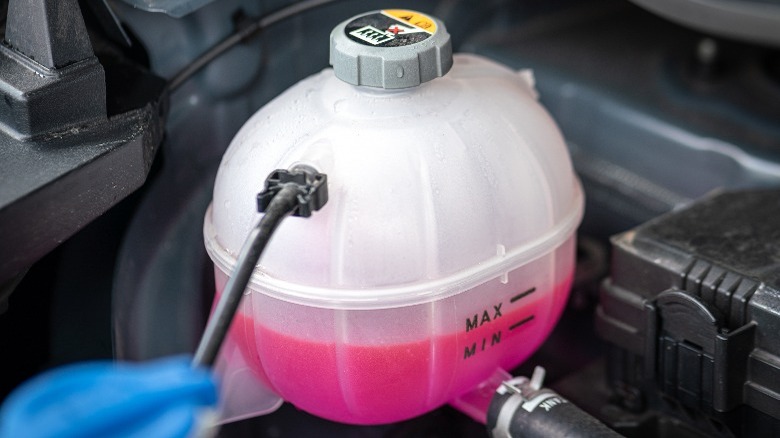
Nattawit Khomsanit/Shutterstock
One of the most common causes of engine overheating is low coolant. Coolant is a combination — usually a 50/50 mixture — of water and antifreeze used to absorb excess heat and carry it away from the engine. It also helps prevent the engine from freezing in extremely low temperatures. Coolant is the lifeblood of your car’s cooling system. The system includes a radiator, water pump, thermostat, hoses and fluid channels through which the coolant flows. As the coolant travels throughout the system, it absorbs heat from the engine. When the coolant returns to the radiator, it sheds that heat and starts the cycle again. However, if the coolant level drops too low, the system won’t be able to remove excess heat properly, resulting in increased engine temperatures and potential damage.
Many issues can cause a low coolant level, but the most common culprit is a leak somewhere in the system. The rubber hoses through which coolant travels can degrade over time, resulting in leak-causing cracks. The remaining cooling system components are more durable but not immune to damage or wear over time. If you notice a puddle of sweet-smelling red, orange, pink, or green liquid beneath your vehicle, you may have a coolant leak. Alternatively, if you notice brightly-colored corrosion in the engine bay, it’s also a strong sign that your car is losing coolant. Finally, coolant can evaporate over time, meaning you may lose coolant even without a leak. You must monitor your coolant level regularly to avoid overheating issues and engine damage.
Low engine oil
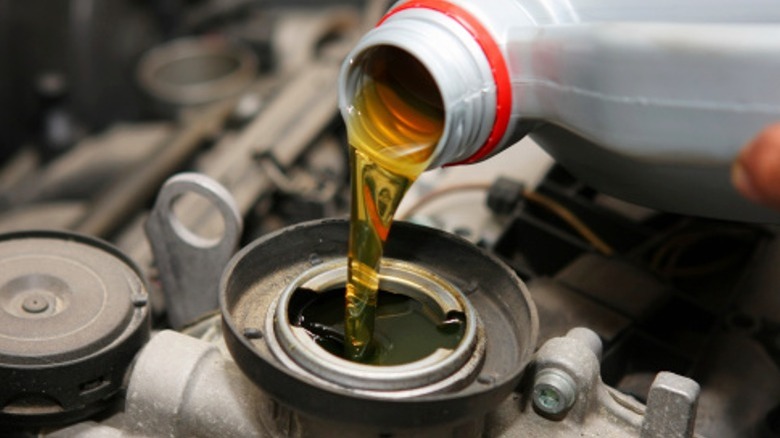
Choja/Getty
Low motor oil is another common cause of an engine overheating. Most drivers know that engine oil lubricates the motor and its internal components. But many people don’t understand what oil does exactly, even as a lubricant. Oil works as a lubricant to prevent friction in the engine. Friction causes heat and can contribute to damage over time. So, engine oil works to prevent overheating as it works as a lubricant. But that’s not all that oil does. It also functions similarly to coolant because it absorbs heat and carries it away from the engine. In that sense, oil works like a heat sink.
If your engine oil drops too low, you’ll encounter various problems, starting with an overheating engine and ending with a potentially seized motor. Oil levels can drop for various reasons, but the most common cause is a leak. Oil leaks are relatively prevalent in older vehicles. Sometimes, oil leaks are extremely minor. But in some cases, a leak can cause your car’s oil level to drop to dangerously low levels, leading to severe damage. You may have an oil leak if you notice dark puddles of thick fluid beneath your car or damp, greasy spots around the engine bay. Another reason your oil level may drop too low is if your car is burning oil. This is much more common in older vehicles with damaged or worn-out parts. If your car smokes excessively or smells strange, it might burn oil. It’s essential to check your oil level regularly and stay up to date on oil changes to prevent overheating issues and much more severe damage.
Faulty water pump
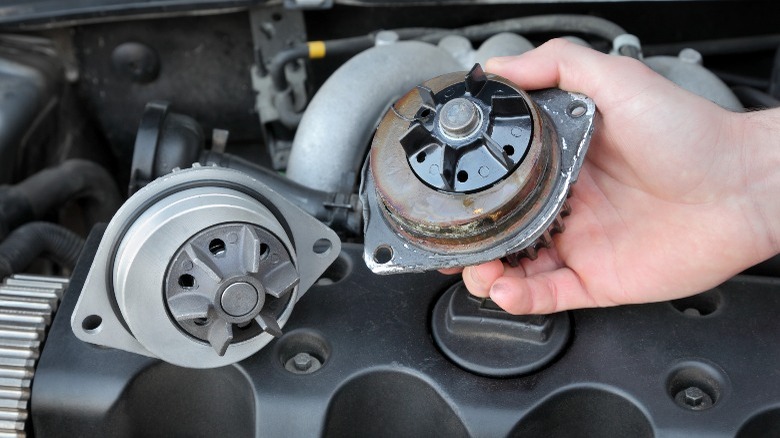
Simazoran/Getty
A water pump is the heart of your car’s cooling system. It sends coolant through the system to absorb and remove excess heat in the engine. While coolant flows through the engine block and cylinder head, the liquid absorbs heat. The water pump continues to propel the coolant through the cooling system via a series of hoses until it reaches the radiator where it sheds excess heat and is cooled by outside air.
Water pumps are subject to wear and tear over time. You can typically expect a water pump to last for at least 60,000 to 90,000 miles, though many will last for more than 100,000 miles. However, once you reach the 100,000-mile mark, you should anticipate replacing your water pump soon. When the water pump stops working, your car’s cooling system can’t function. This can quickly lead to devastating problems, like cooling system leaks, overheating, and even catastrophic engine damage. Some of the most common signs that your water pump is failing include coolant leaks, a buildup of coolant corrosion in the engine bay, unusual grinding or whining noises, and an overheating engine.
You can protect your car’s water pump by following your manufacturer’s recommended maintenance schedule. That means keeping up with routine coolant flushes and adhering to any recommendations regarding water pump replacement — for many vehicles, the manufacturer advises drivers to replace the water pump when they replace the timing belt.
Radiator damage
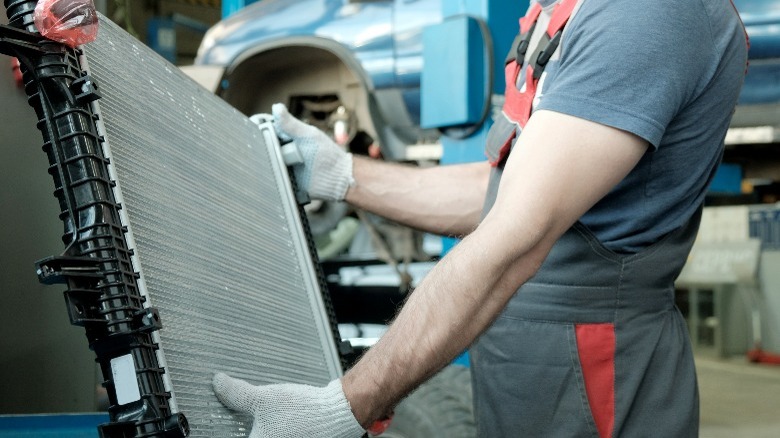
Evgenii Palitsyn/Getty
Your car’s radiator is an essential part of its engine cooling system. It’s responsible for helping the coolant shed the excess heat it absorbs in the engine. The radiator can perform this job thanks to its unique design. Radiators are shaped like large, thin boxes. They’re filled with fluid channels and are covered with small fins or wings. Radiators mount to the front of a vehicle’s engine bay, where cold, outside air flows over and around them. As hot coolant enters the radiator, it travels through a series of fluid channels where it’s cooled down by the outside air flowing over the radiator and releases excess engine heat into the atmosphere.
Due to their position at the front of a car’s engine bay, radiators are subject to intense wear and tear. Bugs and road debris can become stuck in the radiator’s fins, weakening its ability to absorb cool outside air and reduce the coolant’s temperature. Radiators can also become damaged by rocks kicked up by other drivers. Finally, radiators may become clogged if your coolant is extremely old or contaminated. If the radiator develops a leak due to damage or gets impacted by road debris or bad coolant, the entire cooling system will be thrown out of balance. This can lead to issues ranging from minor overheating to complete engine failure. Again, the best way to avoid these problems is to keep up with cooling system maintenance. Outside of routine maintenance, you should inspect your radiator regularly to ensure it’s clean and free of debris or damage.
Belt or pulley damage
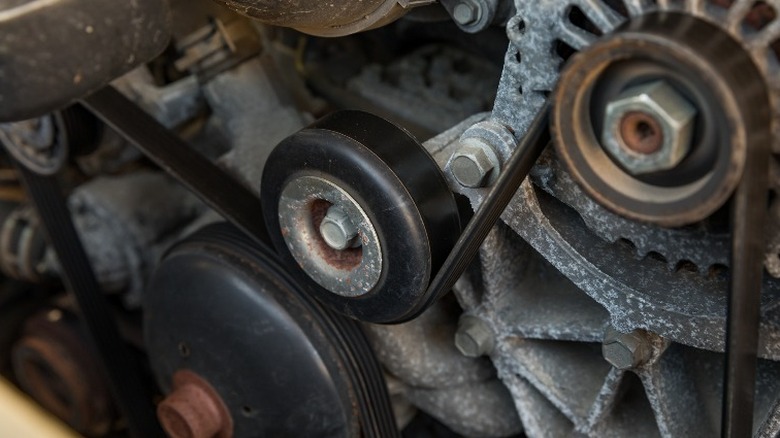
Jj Gouin/Getty
While a few modern luxury vehicles have electric water pumps, most are belt-driven. That means your car’s water pump is most likely powered either by a timing belt or a serpentine belt. Timing belts are usually encased in the engine and must be replaced roughly every 60,000 to 100,000 miles, depending on the car. Timing belt or timing belt pulley failure can cause your water pump to stop working. However, serpentine- or drive belt-powered water pumps are most commonly affected by belt and pulley problems. Serpentine belts power your engine’s accessories, like the AC compressor and the alternator. They get their power from the crankshaft and rely on a system of pulleys to transfer that power to each accessory.
While drive belts and pulleys are relatively durable, they are subject to wear and tear and can fail over time. If this occurs, your car’s water pump — and the rest of its engine accessories — may be unable to function correctly. Some common belt or pulley problems include high-pitched squealing noises and issues with accessory systems, like the AC. Belt and pulley replacement intervals depend on the vehicle, but you can generally expect to replace yours every 50,000 to 100,000 miles. You should consult your owner’s manual to learn more about maintenance intervals and inspect your drive belt regularly to ensure it’s damage-free.